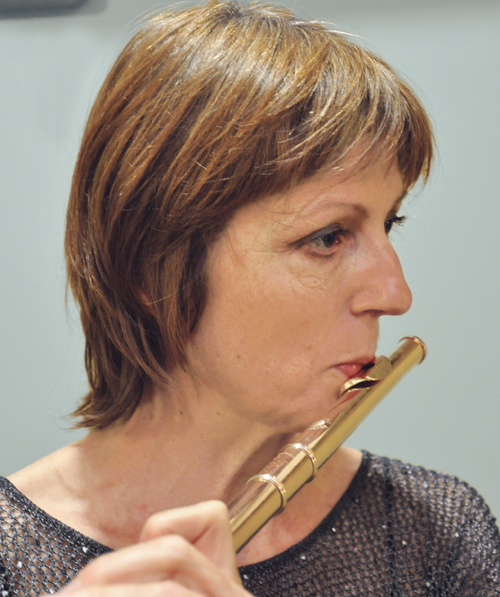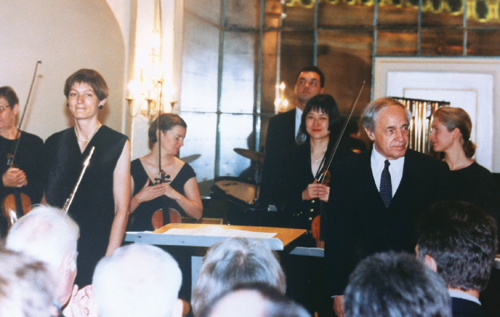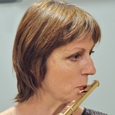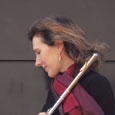
Sophie Cherrier, a native of Nancy, France, studied with Jacques Mule at the Conservatoire National de Région, and later with Alain Marion (flute) and Christian Lardé (chamber music), both at the Conservatoire National Supérieur de Musique de Paris, where she graduated with highest honors. In 1979 she joined the Ensemble Intercontemporain, founded by Pierre Boulez. This unique ensemble is made up of thirty-one soloists dedicated to the performance and promotion of contemporary music. After being awarded the Certificat d’Aptitude, she was appointed Professor at the Conservatoire de Paris in 1998.
What was it like studying at the Paris Conservatory?
It was intimidating at first; I had been the best in my class at Nancy. In Paris I listened to my friends and realized there are so many flutists playing well. However it was very friendly. I made many friends, and we all practiced together. It is emulation that inspires you to practice and do your best. I tell my students that we are all growing together, and don’t think you will be the best. If you are in a competition, of course you try to be the best one, but it is more about doing your personal best. My students support each other. For example, one of them won the audition for the National Orchestra at age twenty-one. The others were so happy for her, even the ones who took part in the same audition.
I remember Anne La Berge telling me once that there is enough art for everybody.
This is perfect, absolutely. I say there are places for everyone, if not in an orchestra then in other groups or in teaching.
What has changed at the Conservatory since you studied there?
Everything has changed; I was only a flute student there for a year and a half because at that time, after you won your première prix, you were finished. I should have done less and stayed longer. Now they have the troisième cycle and apprenticeships, so students stay for five years. As a professor it is very different when you know you will have a student for five years. We now have the Erasmus program that allows students to study abroad for one year, and a piccolo and Baroque flute class which were not options when I was a student.
You were the first woman professor appointed at the Conservatory?
So they tell me, but I was not aware of it at the time. To this day I am still the only woman in the wind department. France is an open society, but in my time, if the choice was between a man and a woman, they took the man. Perhaps it has changed. The gender ratio in my studio has changed; first I had three boys and nine girls, now the ratio is six-six, which is incredible.

How do you choose your students?
I have decided I do not want to compete for students. Nobody should think they must have a private lesson with me first. It is my golden rule: no private lessons. I don’t know who will be on the entrance audition panel, and sometimes I don’t even know the day, and on the day I am the one who says the least. Some of my friends tell me I would be better off choosing my students so I can get a feel for if they are the right ones. Perhaps they are right, but I like to have no prejudice. I do get a student sometimes and think, “whatever am I going to do with him or her?” But this gives me a challenge. I also had a student with whom I was honest, and I told him, “It took me two years to like you.” We were good friends in the end. He really made me think, “What is he really like inside?” If teaching is only Taffanel, I get bored very quickly.
What was it like working with Boulez?
Great! He has been such a big influence on my musicianship since I entered the ensemble at age twenty. At the beginning it was very hard; he has a strong personality and wanted us to do our very best. He taught me many things, ways of seeing the music, its direction and nothing else. He tried to be so honest to the score and to have real integrity. During a workshop he would say, “I want to play this passage,” and I thought, he is conducting, not playing. However, he was playing. You hear things in his conducting that you don’t hear with other conductors. His lines of Anton Webern are so interesting and clear. His own music is the same.
I have the feeling that in Boulez’ music, every note counts for something, no matter how fast.
In Le Marteu sans Maitre, he writes “à laise” over the fast passages, which means “be comfortable.” That is how he prefers it – that no matter how fast, we are comfortable and everything comes out. His Sonatine is very difficult, with all those jumps. It was so new at the time, but it is absolutely possible to do. It is incredible that he was only twenty when he composed it. I have played the Sonatine so many times but can still play it and discover something new. I can’t imagine doing that with the Poulenc Sonata.
Besides teaching, what do you do outside of the Ensemble Intercontemporain?
I don’t do so many things outside the ensemble, the conservatory, and my family. When I was young, there was Rampal, and I honestly thought, even if I had his talent, I would not like to have his life. I went to play a concerto in another city, the orchestra said “bravo” before I even played one note, and then “bravo” afterward, then I went to the hotel and then home. I would not like to do this day in and day out. I enjoy doing things now and then; I was at the NFA convention, two thousand flutists in one hotel, and it was fantastic!
Did you ever wish for an orchestral job?
I went for an audition at the National Orchestra, where I made the finals. One of my friends told me, “you are twenty-three years old; you are better off in the ensemble where you will discover and experience so much more.” He was right. Just after that, we did a very big U.S. tour performing Répons, and I learned so much, so I was happy I did not get that job. A long time later, I decided to try again, just because, when you play contemporary music there can be a stigma. People think you can’t play classically. I took another audition, where they chose nobody, and another where the musicians unanimously voted for me, but the conductor used his droit de veto, although it was his last season.
I reached a point when I thought that I had had enough contemporary music and told myself, when I am forty-three, my apartment will be paid for, so I will leave the ensemble. Then I reached forty-three, and I didn’t want to stop. I want to keep staying young! Two things made me change my mind. Teaching at the conservatoire, I feel I have to play, to show my students that I am still in the life. Of course it is possible to teach even if you can’t play anymore, but for me, like running every day, playing is good for your health. The second thing is the adventure and the different conductors and programs. The ambiance of a small group is special, and I am such good friends with our other flutist, Emmanuelle Ophèle. There is no first or second. We listen to each other in the hall, and we can tell each other anything and know it is meant well.
What is it like working with so many different composers?
There are two approaches. I can take what I already know and show what I can do so a composer will write my ideas. Some composers will work with your specialties, but then you may come up with a piece that no one else can play. Alternatively, you can just receive whatever a composer writes and then figure out how you can do that. Once you have the score, it is interesting to work with the composer, to see what is possible, to explain how the instrument works, and to ask questions. For example, I am working on a new piece by Matthias Pintscher that Emmanuel Pahud commissioned. Everything works, but I find the multiphonics go by so quickly and don’t speak easily. So I think about the music. I know he wants an A, so can I may make my own multiphonic with an A and offer this.
I worked with Luciano Berio on the Sequenza and was surprised when I came to the recording that he insisted I play from the new version. We did the recording very fast, in only an hour and a half. I can understand why he made the new version, but I prefer the old one. I tell my students to work from both; there are some things Berio made more specific, like the fermatas that have to be observed.
Which composers do you think write well for the flute?
Bruno Mantovani writes well for flute, Ivan Fedele is also interesting, his Donax works very well. Heinz Holliger can be interesting but very difficult. His music pushes you to extremes. I don’t like whistle tones very much, but when I played t’aire for the first time, some incredible things happened. The piece is so long, but suddenly you return to this small whistle tone which seems to come from nowhere. The audience becomes very silent; it is so magical.
Do you require your students to learn these pieces?
No, the choice of repertoire is open, and I often let them discover pieces on their own. Of course, I do guide students and tell them what to play next according to what they need. Maybe this student should work on detaché, and this one plays too closed, so I give them Freischutz, or this one has a thin sound, so I suggest Poulenc. I think the interesting repertoire is not so big. Something we should play more of is Baroque music.
I do think that contemporary music is part of the repertoire and shouldn’t be set aside. Contemporary music takes time to learn, though, and it is difficult to find the time because of the many competitions, orchestral studies, and academies. Therefore we spend a lot of time on Mozart. I can’t understand why everyone keeps it on auditions even for 2nd flute players. They will never play it with the orchestra, and perhaps not the first player either. There are so many different ideas of the styles. It is so difficult to play. I have performed the Mozart G Major Concerto maybe ten times. If you miss the beginning, you have the rest of the concerto to show what you can do. At an audition, they listen to young students for only two minutes, and don’t hear the rest. I think it is better to have something simpler, even if it is not great music, to hear the musicianship, pitch, sound, and then have Mozart in the second round.
How do you help prepare your students for auditions and competitions?
As a teacher in a conservatoire, my job is not only one hour a week of saying the pitch is not good, play louder or softer. Rather, it is to open their minds and encourage them to be curious and organize themselves. I had one student whose pitch was not good. Do your own business, I said. Work with pianists; go to the class of sight singing. I must help them hear and understand themselves, which is more interesting than saying, “you should play…” They are not kids; they have their own personalities and stories. The most difficult thing for a teacher is to get the student to become his own teacher. As soon as he decides, my sound is too much, he will change it because he hears it.
It is difficult to hear yourself. A long time ago I recorded the Sonatine by Darius Milhaud. When I listened I thought, what did they do with the microphone? I recognize my high and middle register, but what is going on with the low? And then I realized I was digging way into the sound. Michel Debost says the best teacher is your ear, and it is the least expensive. It’s true. My wish is to play in a hall, run faster than the sound in order to hear myself, and to know the truth. Otherwise you can live with the dream that you play very well.
Do you teach extended techniques to your students?
Absolutely. To make the air column more active I use air (aeolian) sounds. Most of the time we don’t blow enough in our instruments, or we blow but we are tight everywhere. Nearly every day I speak about this. Sometimes I will ask a student to play the Ibert Concerto, second movement, only with air. They look at me funny, but I say it is only a color, don’t be afraid. You will not lose your sound, but it will change the way you listen to your sound. When you have a color, if you don’t bring it with the air into the hall, it will stay at your feet. You can also, for example, do ten minutes of scales with aeolian sounds, then play normally, and you will have a very big sound. I do this only with those students who have a very good embouchure. If someone’s tone is unstable and already has too much air, I am not going to put more air in the sound.
Sometimes I use slap tongue for Berio Sequenza, to explain the valve motion of the tongue and to avoid the “duh, duh, duh” kind of articulation. Sometimes to understand the speed of air I use fast tongue ram. You can’t play them fast without using the air column. I use a lot of these sorts of things, not the trumpet sound like Aurèle Nicolet, nor whistle tones. To be supple it is good to work on multiphonics, especially harmonic multiphonics, and especially octaves, to understand how close they are to each other when playing intervals. Singing and playing is good for students who have not enough energy, not enough speed of air.
What do you enjoy doing when not teaching or playing?
I used to run, and enjoyed cross country skiing, hiking, and Salsa dancing. I really liked rock climbing, but twice injured my finger. Now I go to the cinema or to museums when on tour. It’s funny how I never do that at home in Paris.
Which aspect of your career do consider most important?
I have been teaching since I was eighteen and have never stopped. I took a break from the ensemble for seven months, but continued teaching. If I had to choose, I would choose to teach. It is my passion.






